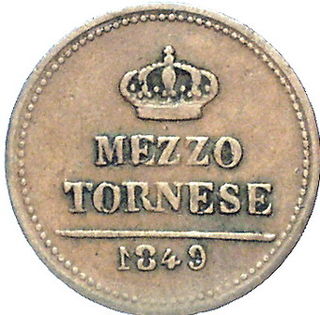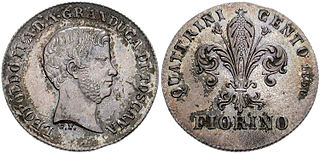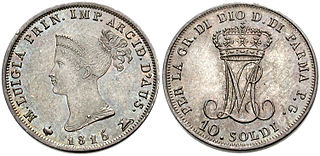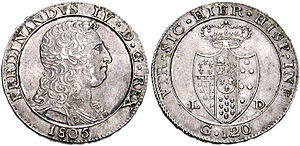
Kuruş, also gurush, ersh, gersh, grush, grosha, and grosi, are all names for currency denominations in and around the territories formerly part of the Ottoman Empire. The variation in the name stems from the different languages it is used in and the different transcriptions into the Latin alphabet. In European languages, the kuruş was known as the piastre.

The lira was the currency of Italy between 1861 and 2002. It was introduced by the Napoleonic Kingdom of Italy in 1807 at par with the French franc, and was subsequently adopted by the different states that would eventually form the Kingdom of Italy in 1861. It was subdivided into 100 centesimi, which means "hundredths" or "cents". The lira was also the currency of the Albanian Kingdom from 1941 to 1943.

The rupia was the currency of Portuguese India sometime after 1668 until 1958. Prior to 1668, the currency unit was Xerafim. In 1666, the Portuguese administration struck a silver coin calling it double xerafin and this was declared equal to a rupia in circulation in India outside of Portuguese possessions. A xerafim was a convertible subunit of rupia, and it was unique to Portuguese colonies in India. One rupia equalled two xerafims.

The Somalo was the currency of the Trust Territory of Somaliland administered by Italy between 1950 and 1960. The "Somalo" remained officially in use in the newly created Somali Republic until 1962. It was subdivided into 100 centesimi.

The rixdollar was the currency of British Ceylon until 1828. It was subdivided into 48 stivers, each of 4 duit. Units called the fanam and larin were also used, worth 4 and 9½ stiver, respectively. The currency derived from the Dutch rijksdaalder and stuiver, although the rijksdaalder was worth 50 stuiver.

The lira was the currency of the Kingdom of Sardinia between August 6, 1816, and March 17, 1861.

The ducat was the main currency of the Kingdom of the Two Sicilies between 1816 and 1860. When the Congress of Vienna created the kingdom merging the Kingdom of Naples and the Kingdom of Sicily, the ducat became at par a continuation of the Neapolitan ducat and the Sicilian piastra issued prior to 1816, although the Sicilian piastra had been subdivided into 240 grana. In the mainland part of the kingdom, the ducat also replaced the Napoleonic lira.

The Tuscan fiorino was the currency of Tuscany between 1826 and 1859. It was subdivided into 100 quattrini, a local currency made by four denari. There was an additional denomination called the paolo, worth 40 quattrini, in circulation.

The lira was the currency of the Grand Duchy of Tuscany until its annexation by Napoleonic France in 1807. After that year, it unofficially remained in circulation thanks to its silver value until the restoration of Tuscan independence in 1814. It was finally abolished in 1826.

The Roman scudo was the currency of the Papal States until 1866. It was subdivided into 100 baiocchi, each of 5 quattrini. Other denominations included the grosso of 5 baiocchi, the carlino of 7+1⁄2 baiocchi, the giulio and paoli both of 10 baiocchi, the testone of 30 baiocchi and the doppia of 3 scudi.
The real was the currency of Argentina until 1881. From 1822, it was subdivided into 10 décimos. The sol was also issued during this period and was equal to the real, whilst the peso was worth 8 reales and the escudo was worth 16 reales.

The Somali rupia was the currency in Italian Somaliland from 1909 to 1925. It was subdivided into 100 bese.
The scudo was the currency of Milan until 1806. It was subdivided into 6 lire, each of 20 soldi or 240 denari.
The lira was the currency of the Republic of Lucca until 1800 and again of the Duchy of Lucca between 1826 and 1847. It was subdivided into 20 soldi, each of 3 quattrini or 12 denari.

The piastra was the distinct currency of the Kingdom of Sicily until 1815.
The lira was the currency of the mainland part of the Kingdom of the Two Sicilies, known as the Kingdom of Naples, between 1812 and 1813.

The lira was the distinct currency of Parma before 1802 and again from 1815 to 1859.
The scudo was the currency of the island Kingdom of Sardinia until 1816.

The scudo was the currency of the Piedmont and the other mainland parts of the Savoyard Kingdom of Sardinia until 1816.

Italy has a long history of different coinage types, which spans thousands of years. Italy has been influential at a coinage point of view: the medieval Florentine florin, one of the most used coinage types in European history and one of the most important coins in Western history, was struck in Florence in the 13th century, while the Venetian sequin, minted from 1284 to 1797, was the most prestigious gold coin in circulation in the commercial centers of the Mediterranean Sea.















